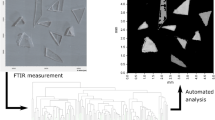Abstract
Hyperspectral imagery including rich spectral information could be applied to detect and identify objects at a distance. In this paper, we concentrate on the surface material identification of interested objects within the domain of space object identification (SOI) and geological survey. One of the approaches is the unmixing analysis that identifies the components (called endmembers) in each pixel and estimates their corresponding fractional abundances, and then, we could obtain the space distributions of substances. To solve this problem, we present an approach in a semi-supervised fashion, by assuming that the measured spectrum is expressed in the form of linear combination of a number of pure spectral signatures in a spectral library and the fractional abundances are their weights. Thus, the abundances are sparse and we propose a sparse regression model to realize the sparse unmixing analysis. We apply random projection technique to accelerate the sparse unmixing process and use split Bregman iteration to optimize the objective function. Our algorithm is tested and compared with other classic algorithms by using simulated hyperspectral images and a real-world image.
















Similar content being viewed by others
References
Adams JB, Smith MO, Johnson PE (1986) Spectral mixture modeling: a new analysis of rock and soil types at the Viking Lander 1 site. J Geophys Res 91: 8098–8112
Bioucas-Dias JM, Plaza A (2010) Hyperspectral unmixing: geometrical, statistical, and sparse regression-based approaches. In: Proceedings of SPIE international society for optical engineering V, 7830
Boardman JW, Kruse FA, Green RO (1995) Mapping target signatures via partial unmixing of AVIRIS data. In: Proceedings of JPL airborne earth science workshop, pp 23–26
Winter ME (2003) N-FINDR: an algorithm for fast autonomous spectral endmember determination in hyperspectral data. In: Proceedings of SPIE image spectrometry V, 3753: 266–277
Ren H, Chang C-I (2003) Automatic spectral target recognition in hyperspectral imagery. IEEE Trans Aerosp Electron Syst 9(4): 1232–1249
Nascimento JMP, Bioucas-Dias JM (2005) Vertex component analysis: a fast algorithm to unmix hyperspectral data. IEEE Trans Geosci Remote Sens 43(4): 898–910
Iordache M-D, Bioucas-Dias JM, Plaza A (2011) Sparse unmixing of hyperspectral data. IEEE Trans Geosci Remote Sens 49(6): 2014–2039
Chan TH, Chi CY, Huang YM, Ma WK (2009) A convex analysis-based minimum-volume enclosing simplex algorithm for hyperspectral unmixing. IEEE Trans Geosci Remote Sens 47(11): 4418–4432
Chen J, Jia X, Yang W, Matsushita B (2009) Generalization of subpixel analysis for hyperspectral data with flexibility in spectral similarity measures. IEEE Trans Geosci Remote Sens 47(7): 2165–2171
Vempala S (2004) The random projection method. American Mathematical Society, Providence
Achlioptas D (2003) Database-friendly random projections: Johnson–Lindenstrauss with binary coins. J Comput Syst Sci 66(4): 671–687
Newman MEJ (2005) Power laws, pareto distributions and zipf’s law. Contemp Phys 46(5): 232–351
Achlioptas D, McSherry F, Scholkopf B (2001) Sampling techniques for kernel methods. In: Proceedings of NIPS, pp 335–342
Arriaga R, Vempala S (1999) An algorithmic theory of learning: robust concepts and random projection. In: Proceedings of FOCS (also to appear in machine learning), pp 616–623
Goldstein T, Osher S (2009) The split Bregman method for l1 regularized problems. SIAM J Imaging Sci 2(2):323–343
Pati YC, Rezahfar R, Krishnaprasad P (2003) Orthogonal matching pursuit: recursive function approximation with applications to wavelet decomposition. In: Proceedings of the 27th annual asilomar conference on signals, systems and computers, Los Alamitos
Chen S, Donoho D, Saunders M (2001) Atomic decomposition by basis pursuit. SIAM Rev 43(1): 129C159
Zhang Q, Wang H, Plemmons R, Pauca P (2008) Tensor methods for hyperspectral data analysis: a space object material identification study. J Opt Soc Am A 25(12): 3001–3012
Swayze GA, Clark RL, Sutley S, Gallagher AJ (1992) Ground-truthing AVIRIS mineral mapping at cuprite, nevada. In: Summaries of the 3rd annual JPL airborne geoscience workshop, vol 1, pp 47–49
Miao LD, Qi HR (2007) Endmember extraction from highly matrix data using minimum volume constrained nonnegative matrix factorization. IEEE Trans Geosci Remote Sens 45(3):765–777
Acknowledgments
The work was supported by the National Natural Science Foundation of China under the Grants 61273245, 60975003 and 91120301, the 973 Program under the Grant 2010CB327904, the open funding project of State Key Laboratory of Virtual Reality Technology and Systems, Beihang University (Grant No. BUAA-VR-12KF-07), the Beijing Natural Science Foundation (Non-negative Component Analysis for Hyperspectral Imagery Unmixing) under the Grant 4112036, and Program for New Century Excellent Talents in University of Ministry of Education of China under the Grant NCET-11-0775.
Author information
Authors and Affiliations
Corresponding author
Rights and permissions
About this article
Cite this article
Shi, Z., Liu, L., Zhai, X. et al. Efficient sparse unmixing analysis for hyperspectral imagery based on random projection. Neural Comput & Applic 23, 2281–2293 (2013). https://doi.org/10.1007/s00521-012-1179-8
Received:
Accepted:
Published:
Issue Date:
DOI: https://doi.org/10.1007/s00521-012-1179-8




